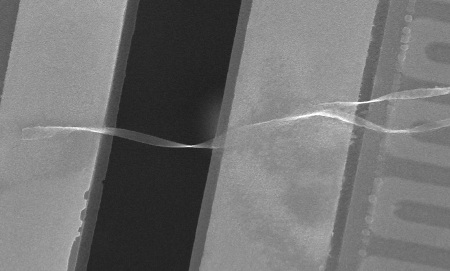A research team led by Deyu Li, who serves as an associate professor of mechanical engineering at Vanderbilt University, has developed a novel method to modify and improve the thermal conductivity of boron nanoribbons, paving the way for controlling thermal impacts in lasers, computers, smart phones and other powered devices.
 A pair of boron nanoribbons stuck together on a microdevice used to measure thermal conductivity (Credit: Deyu Li)
A pair of boron nanoribbons stuck together on a microdevice used to measure thermal conductivity (Credit: Deyu Li)
During its process to join two boron nanoribbon strips, the research team accidentally found that the material’s thermal conductivity can be improved to a maximum 45%. According to the team, this effect can also be demonstrated in other thin film materials. Li stated that the two nanoribbon strips were bonded together by a weak electrostatic force named as van der Waals force.
Contrary to the classical view, the research team demonstrated that phonons are capable of crossing van der Waals interfaces without getting scattered, resulting in the improvement of thermal conductivity, Li said. Moreover, the team discovered that the thermal conductivity of the material can be manipulated between a low and high value by wetting the nanoribbon pair’s interface with various solutions.
Another notable feature of the novel method developed by the Li team is that it can be reversed. For instance, the thermal conductivity of the nanoribbon pair was equivalent to that of an individual nanoribbon, when the team wetted the nanoribbon pair’s interface with isopropyl alcohol, attached the nanoribbons together, and allowed them to dry. However, the thermal conductivity of the nanoribbon pair improved when they repeated the steps with pure alcohol. The team then brought back the thermal conductivity value of the nanoribbon pair to the original value by repeating the steps once again with isopropyl alcohol.
This method finds applications in heat management of microelectronic devices such as computer chips to eliminate overheating. The method can also be used to develop nanocomposites, which are nanomaterials produced by implanting nanostructures such as carbon nanotubes into a host matrix made of different polymers, for aircrafts and flexible electronics.